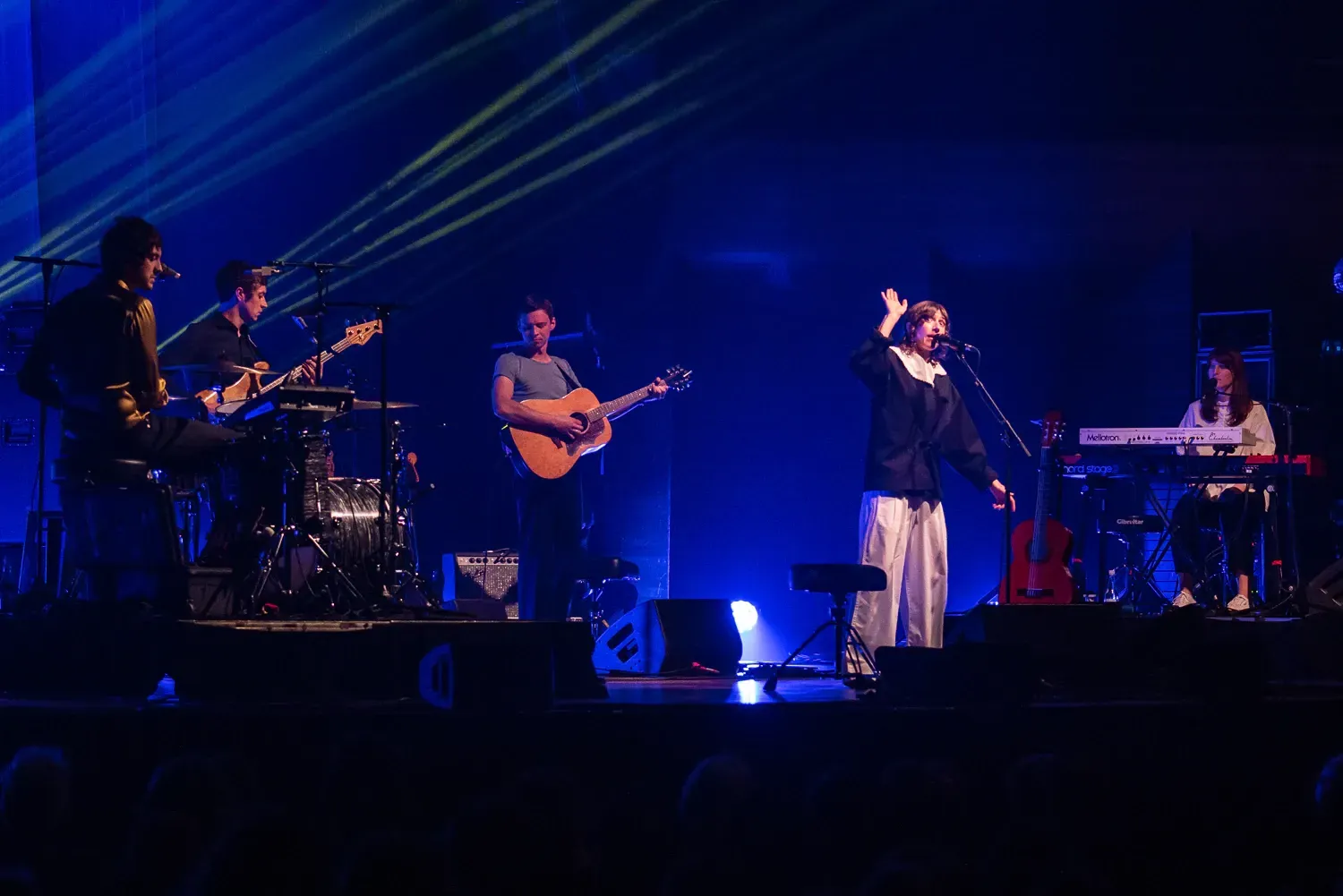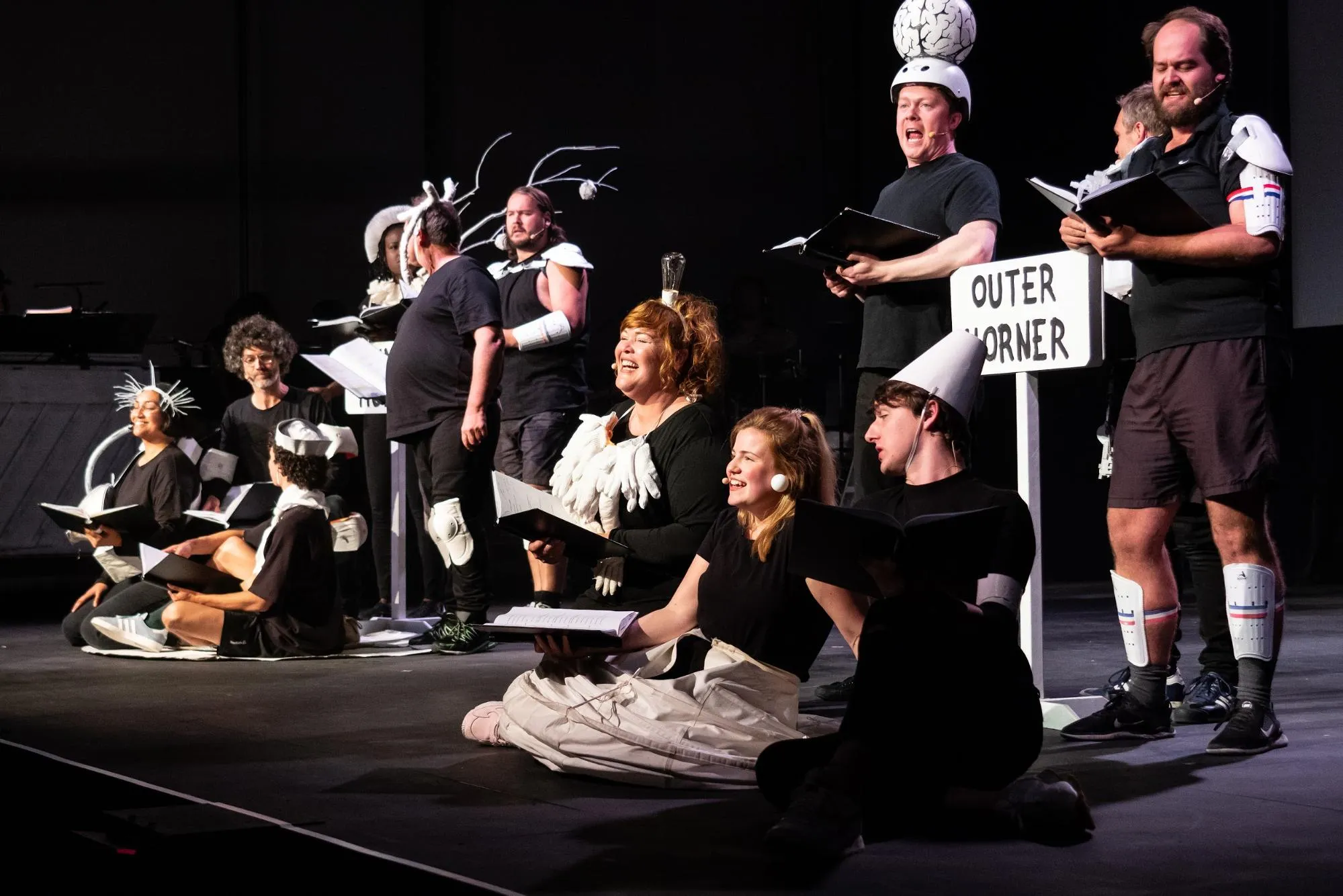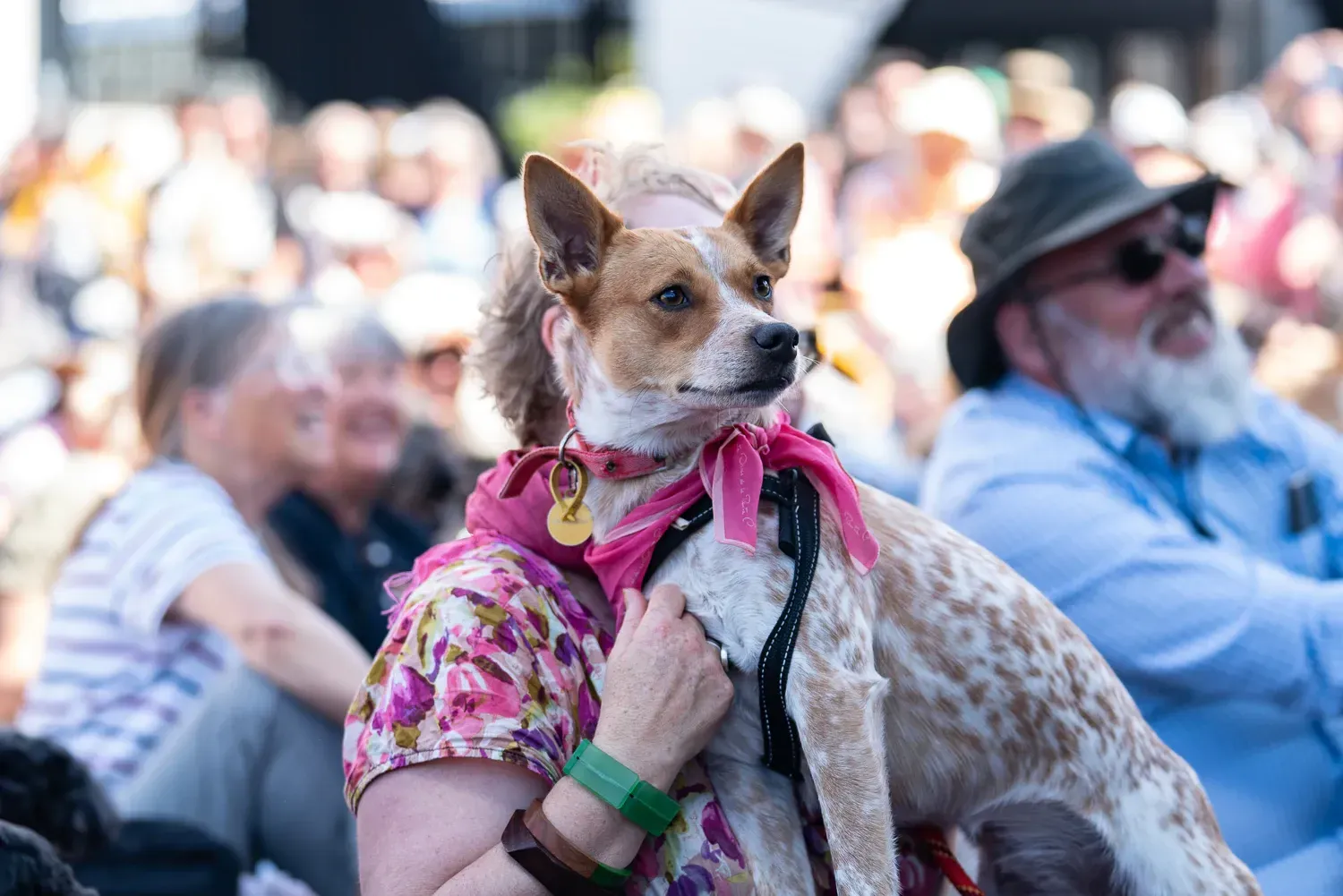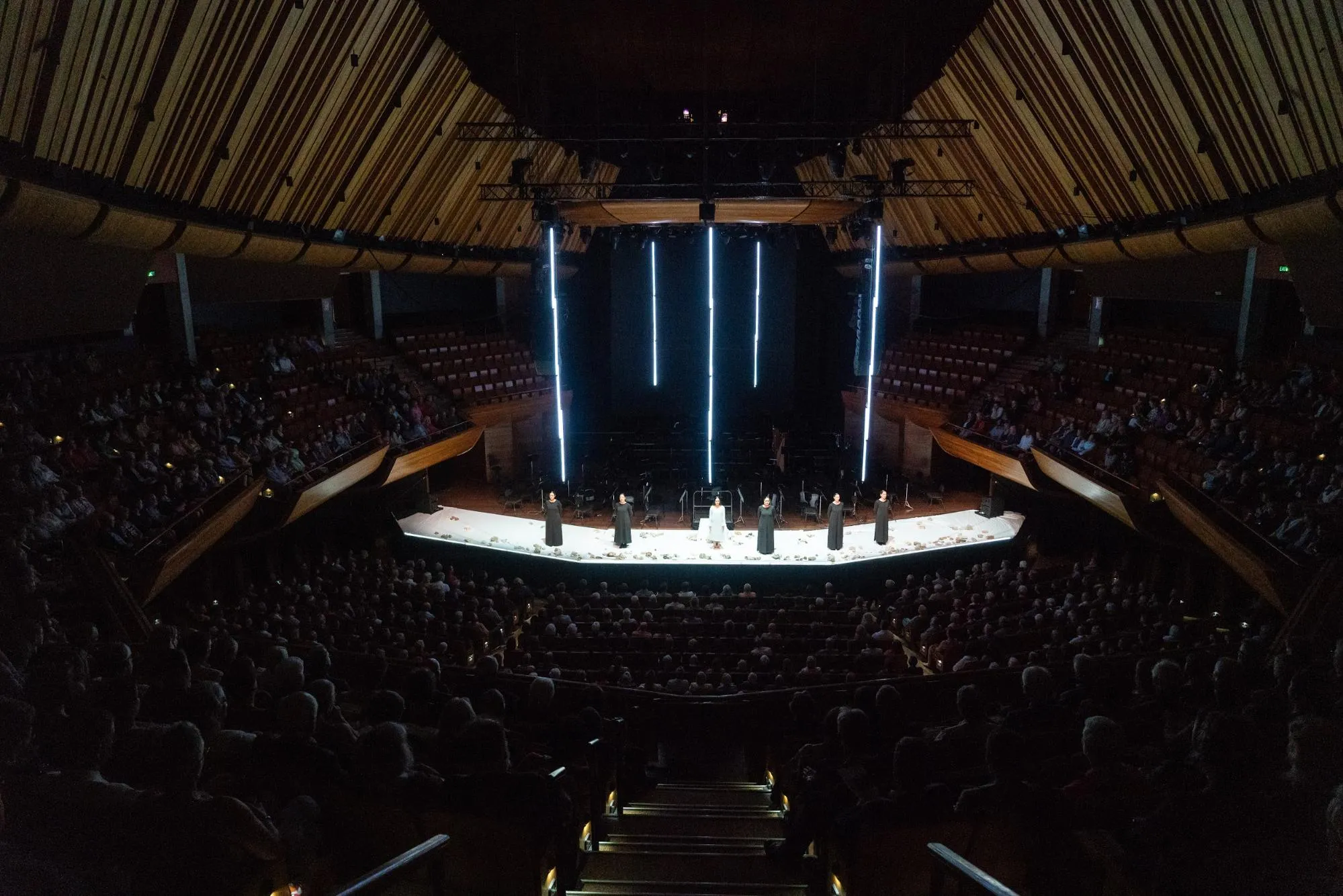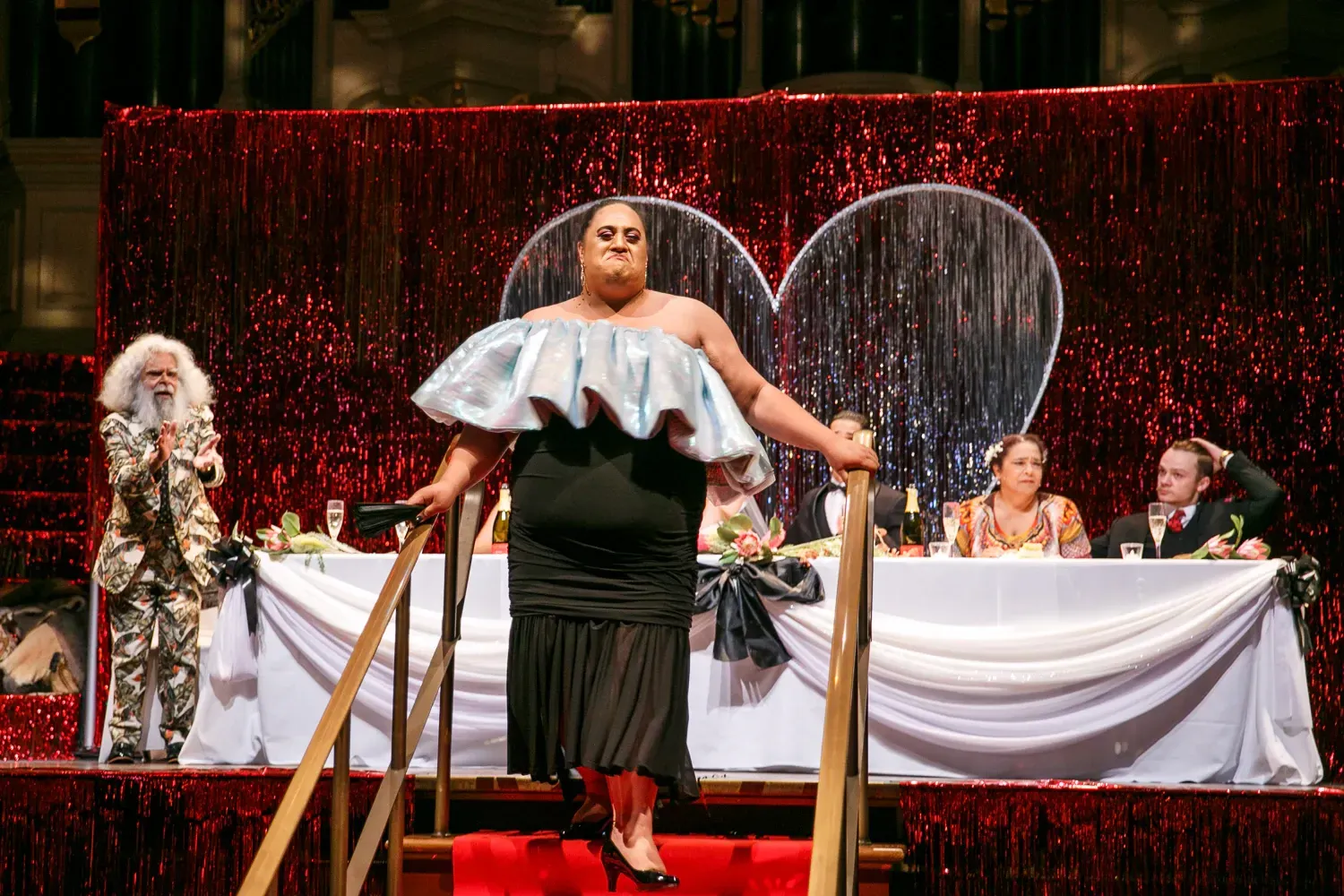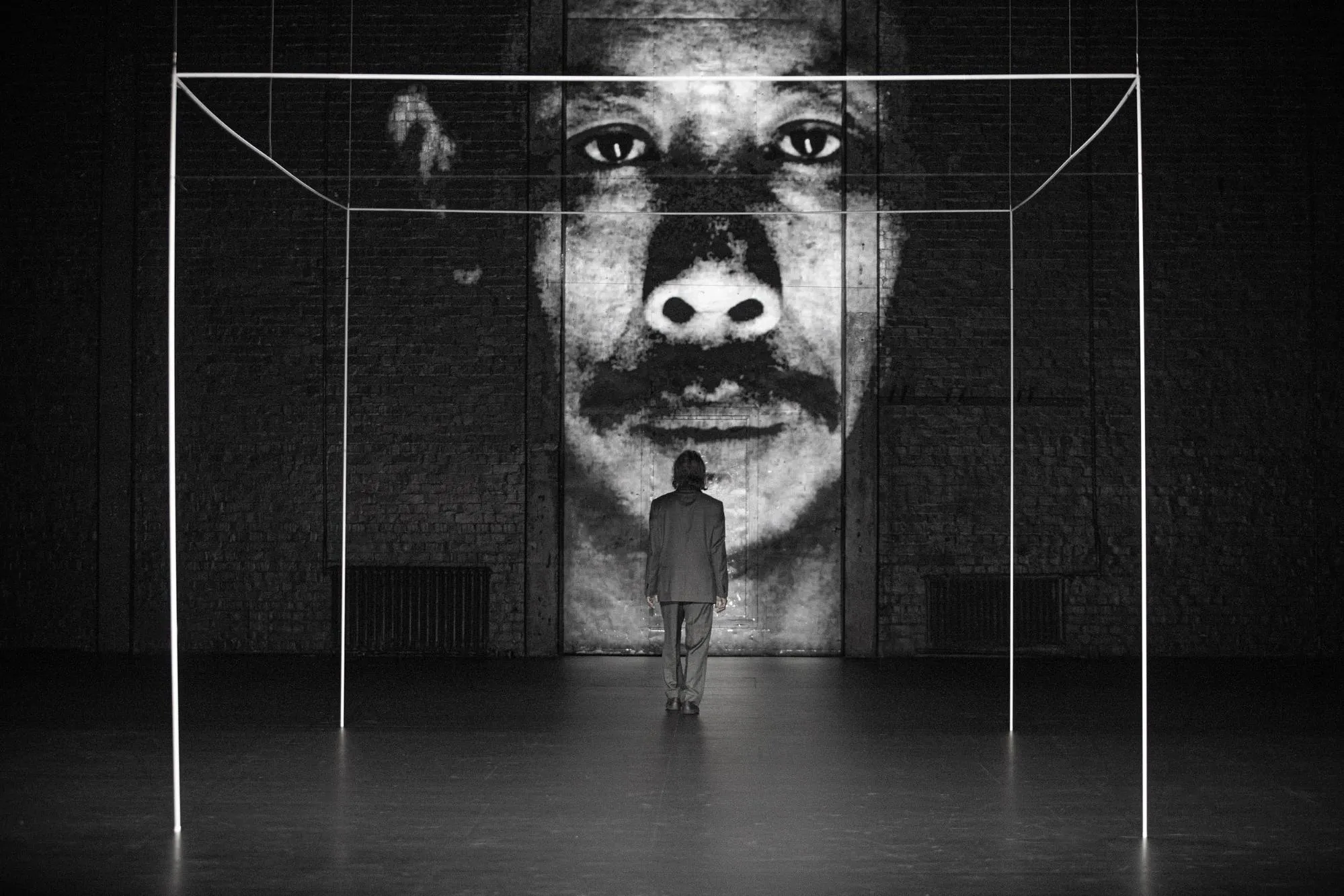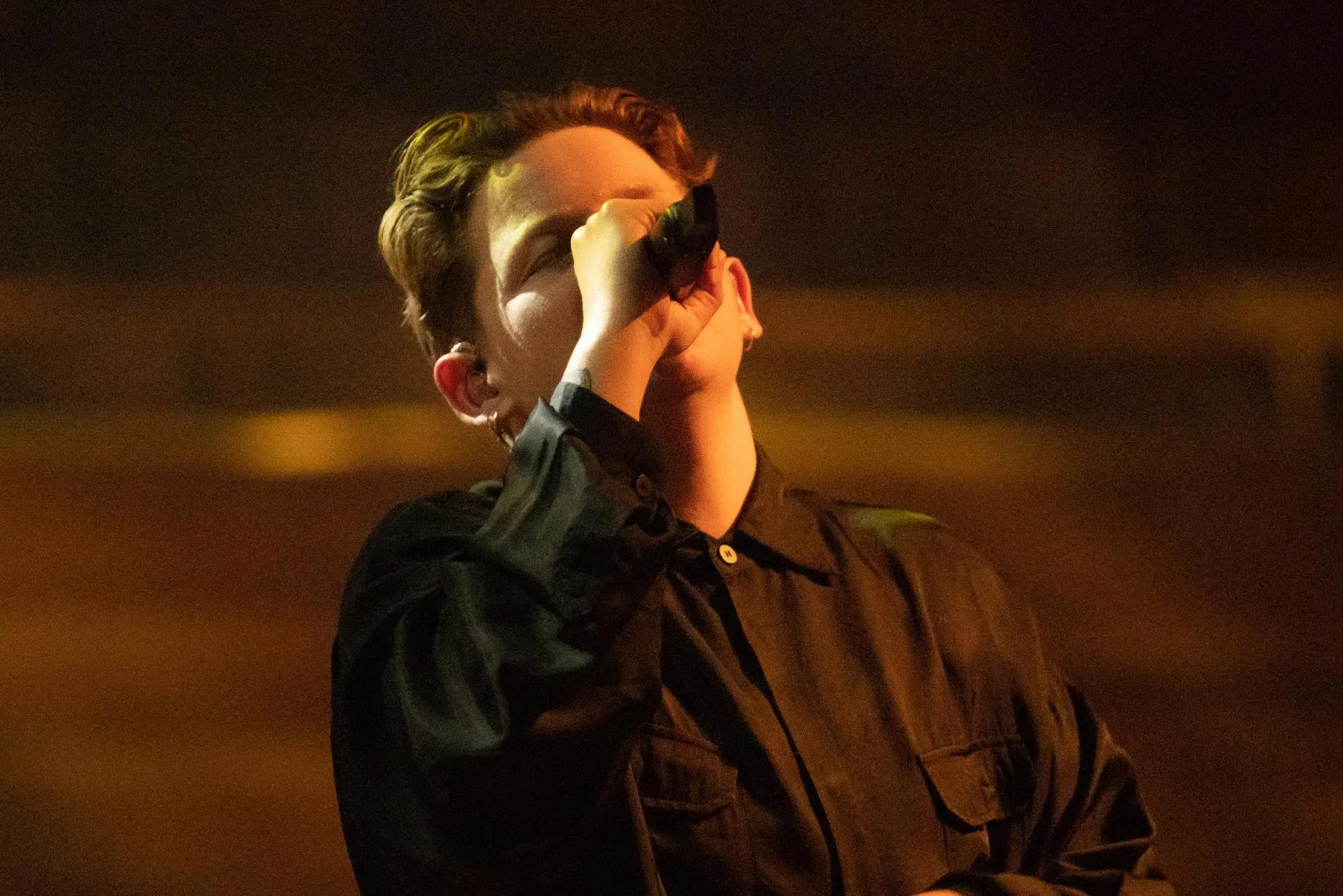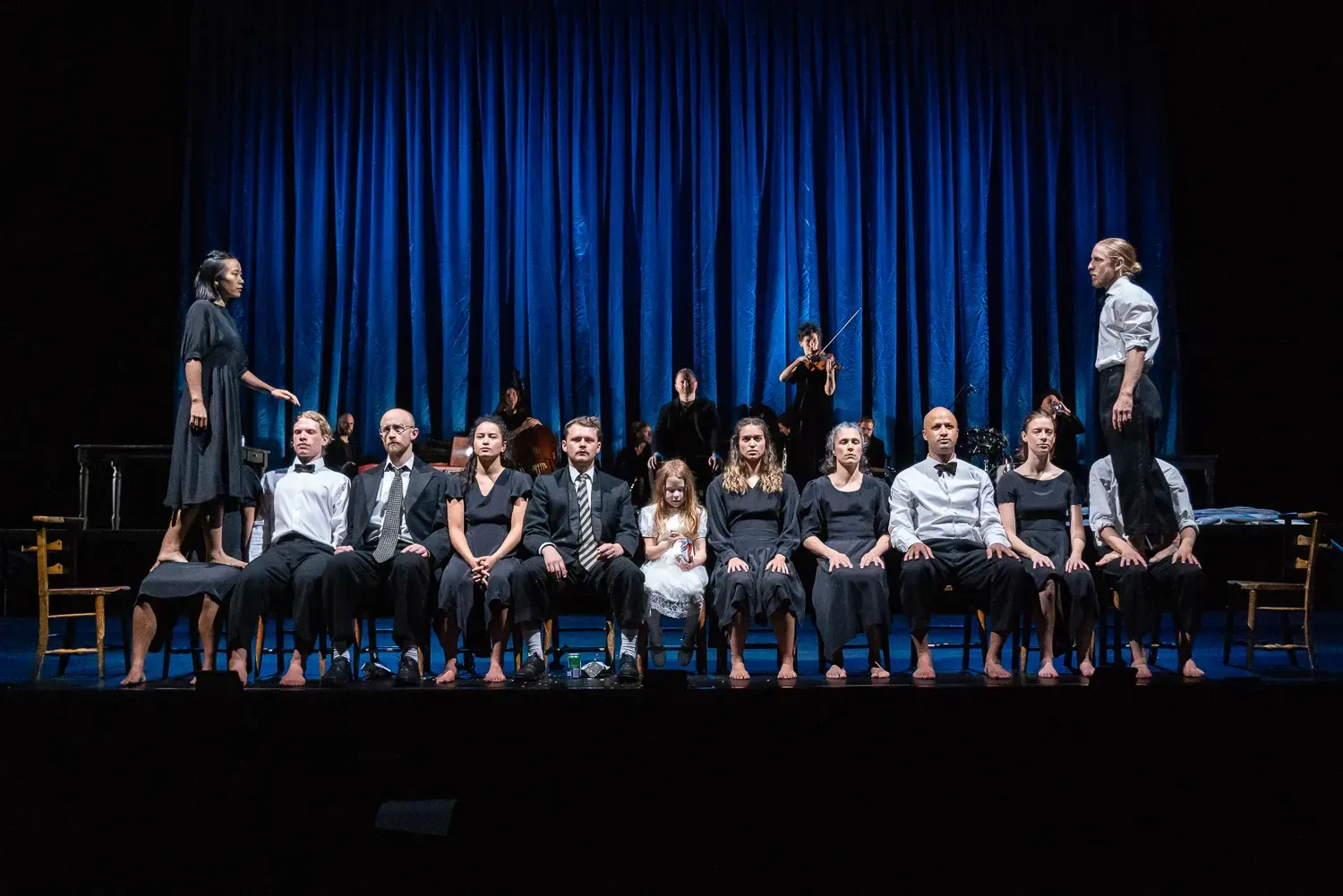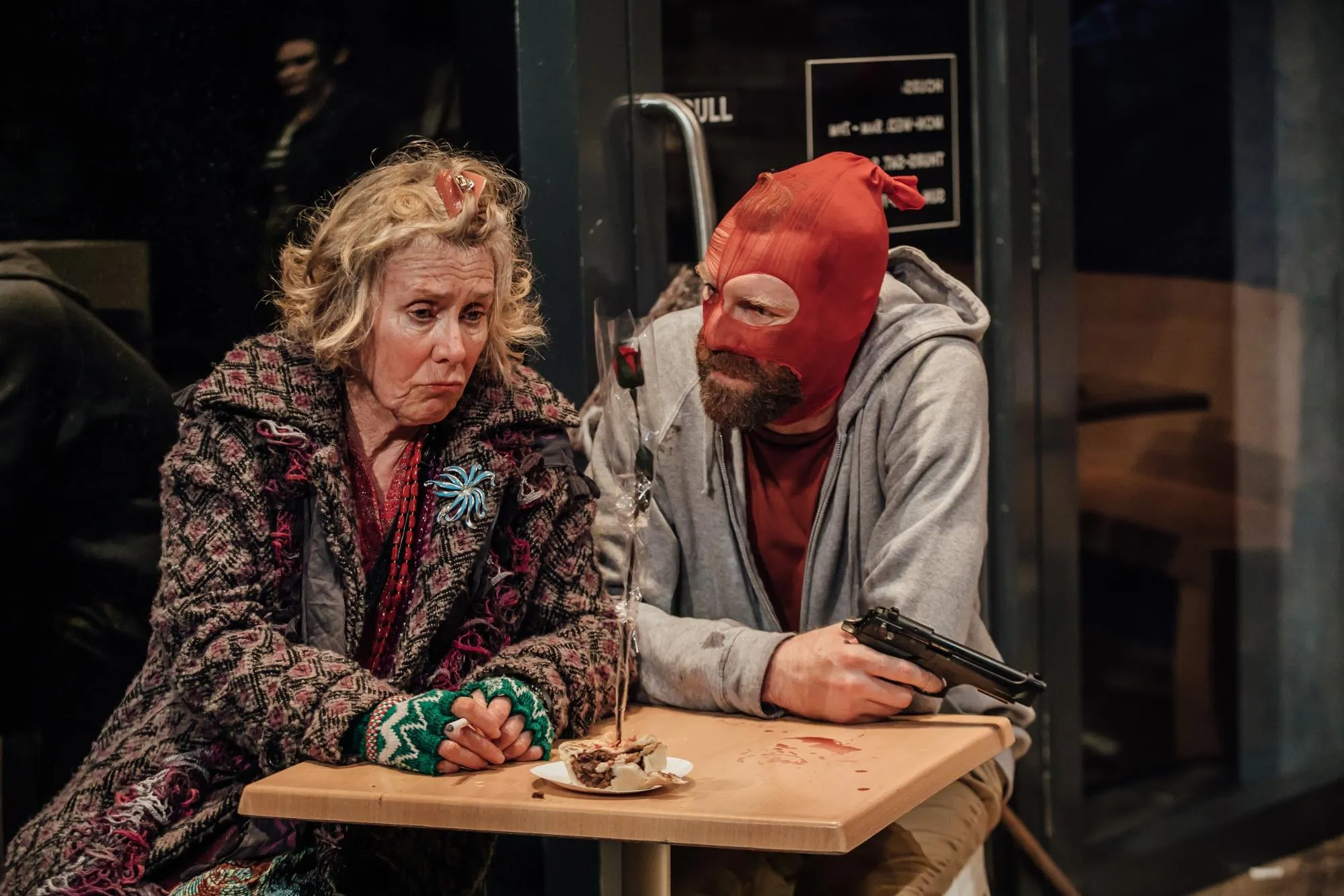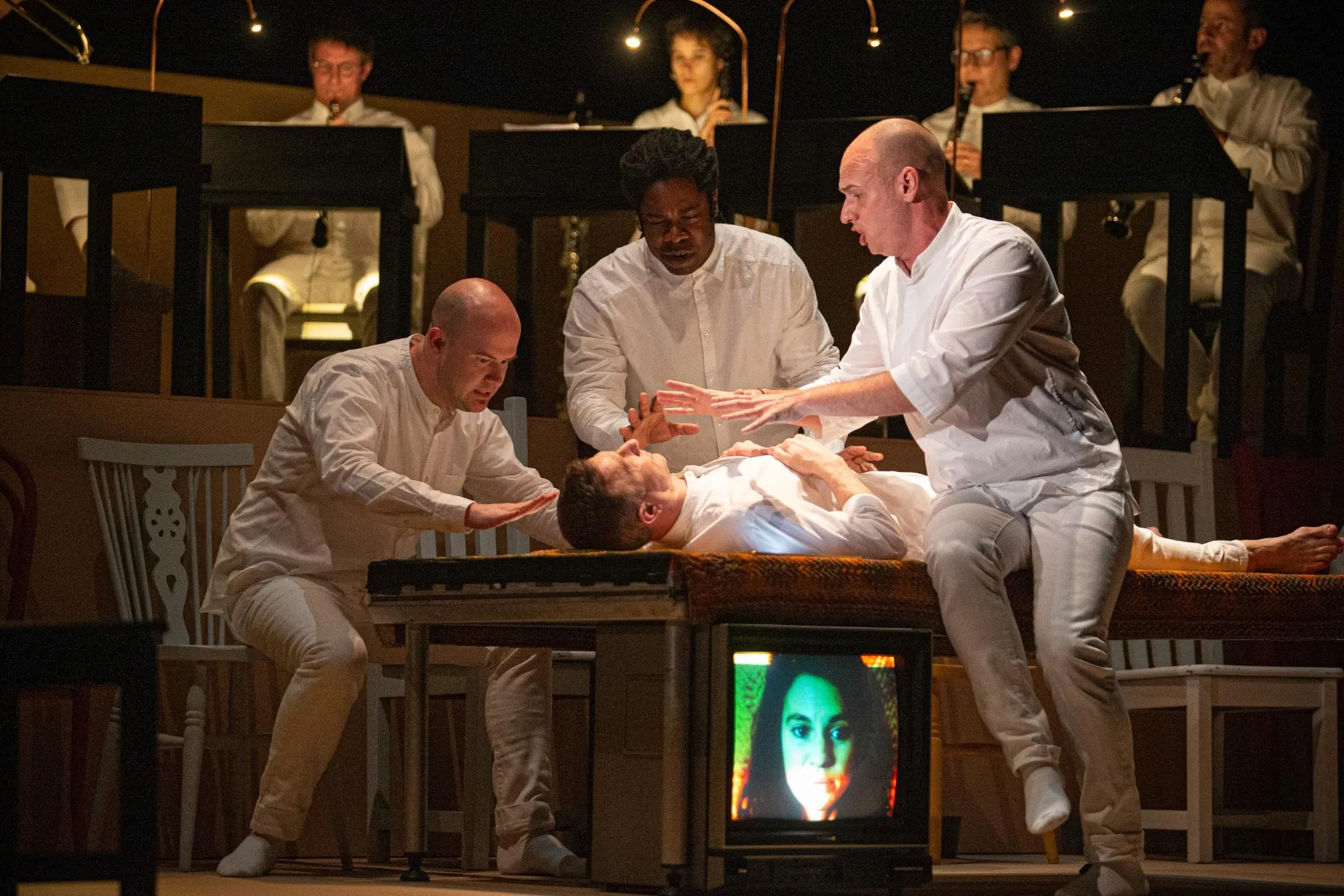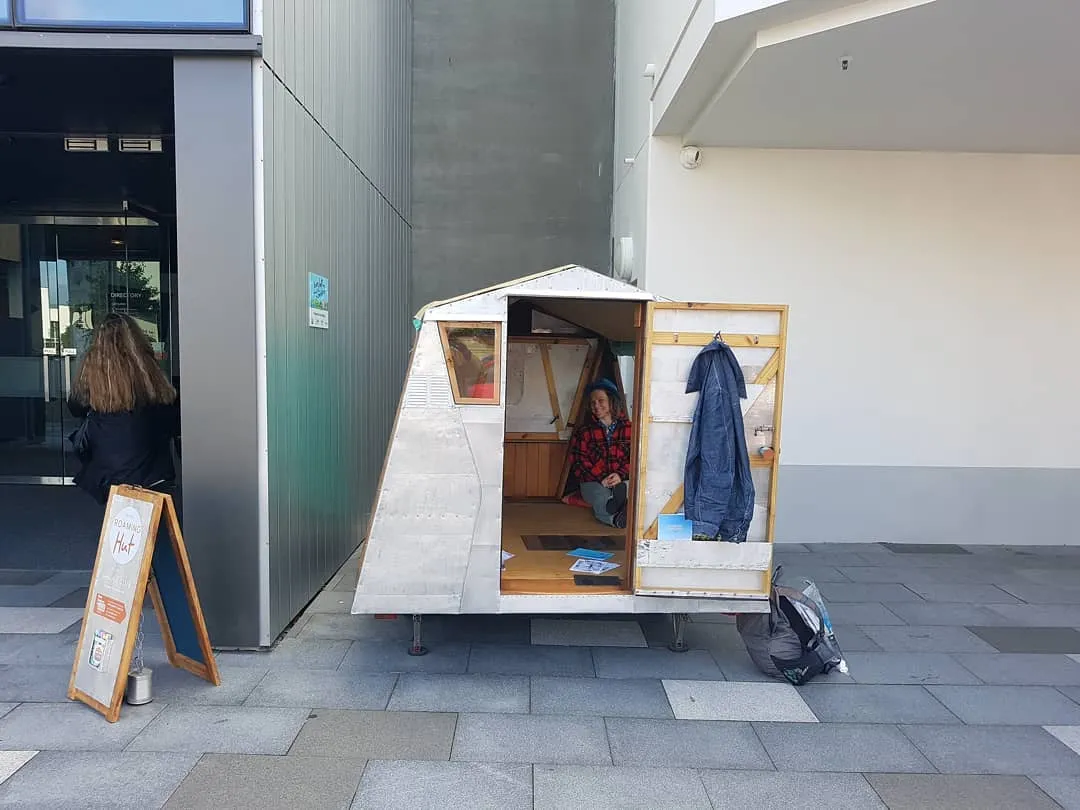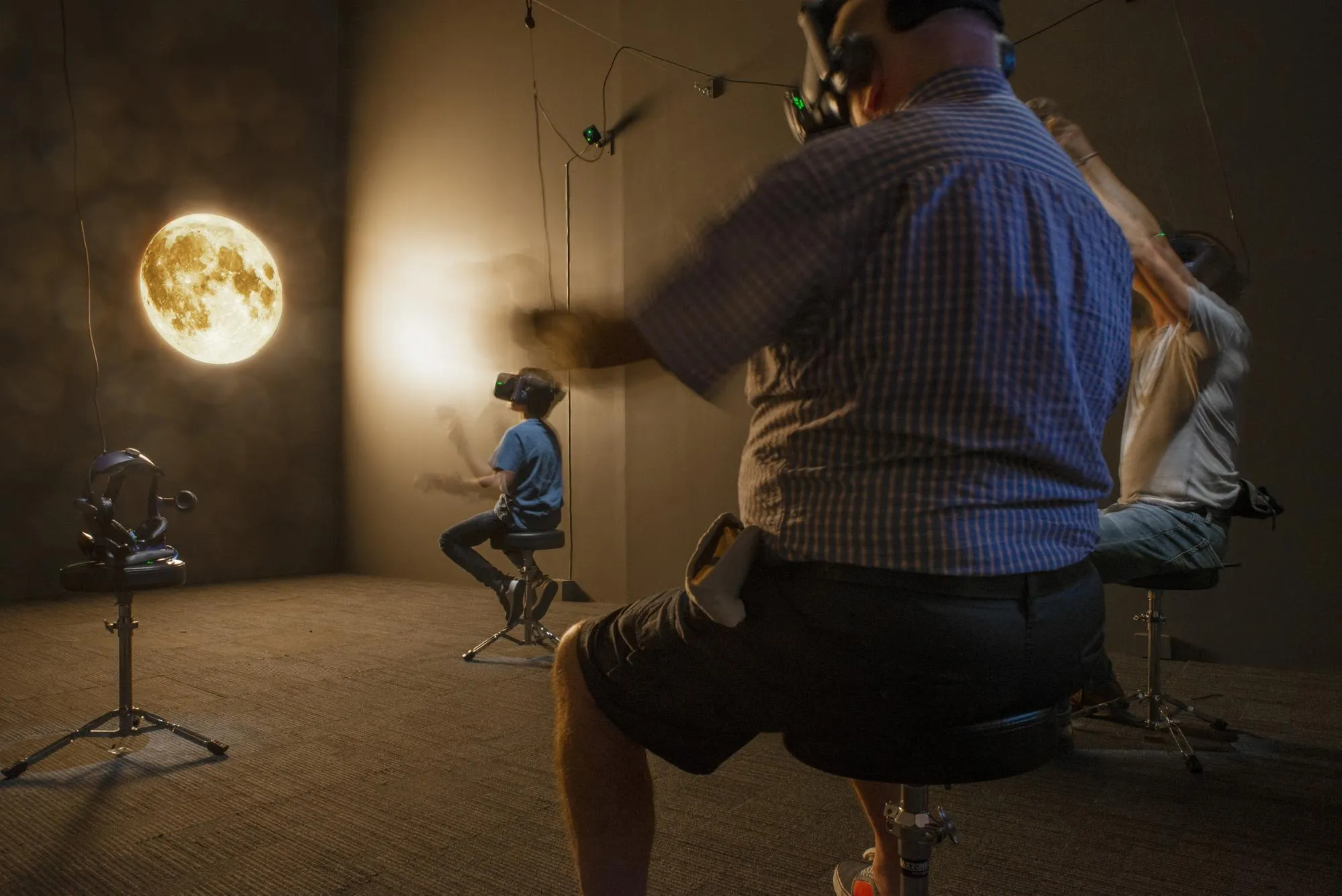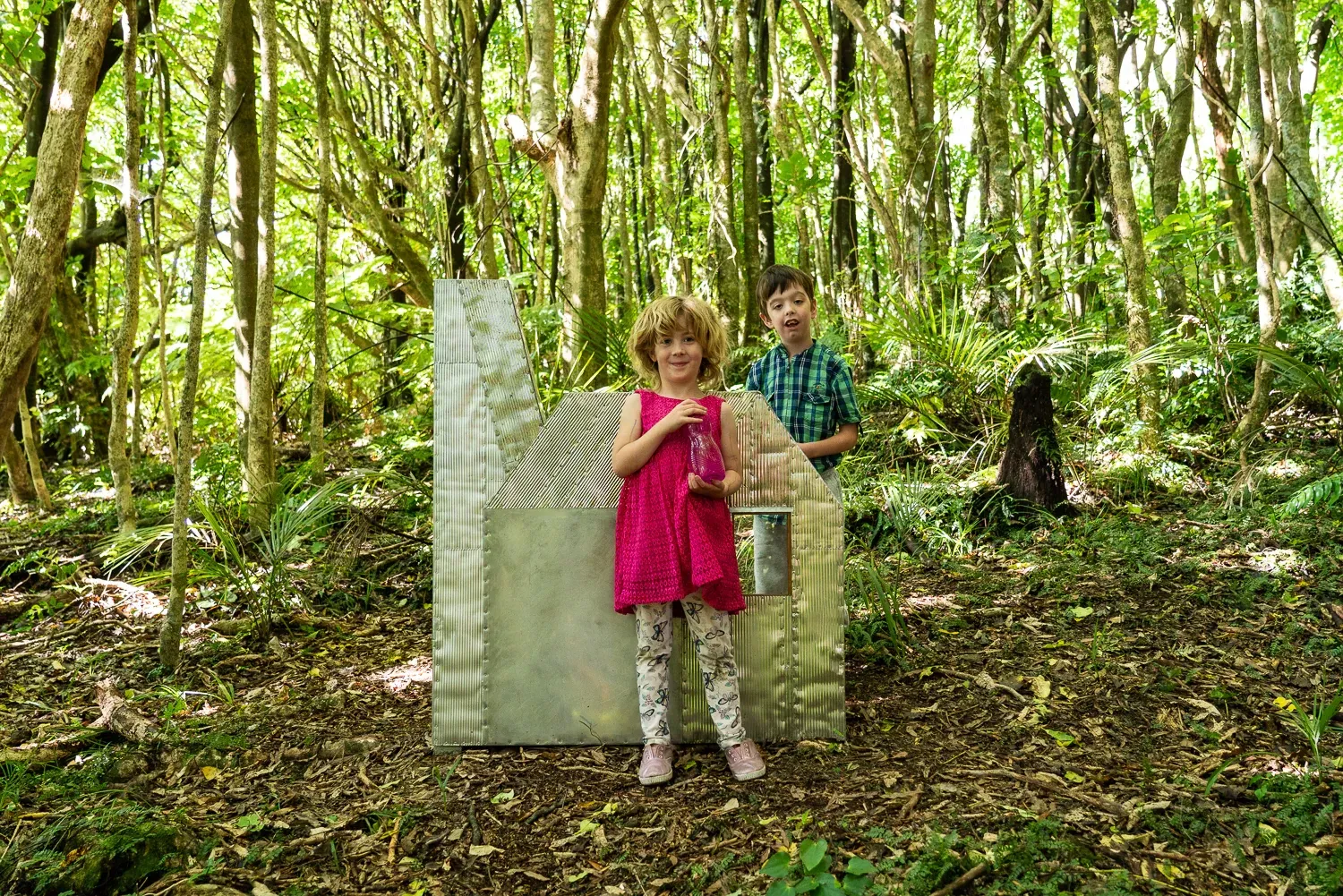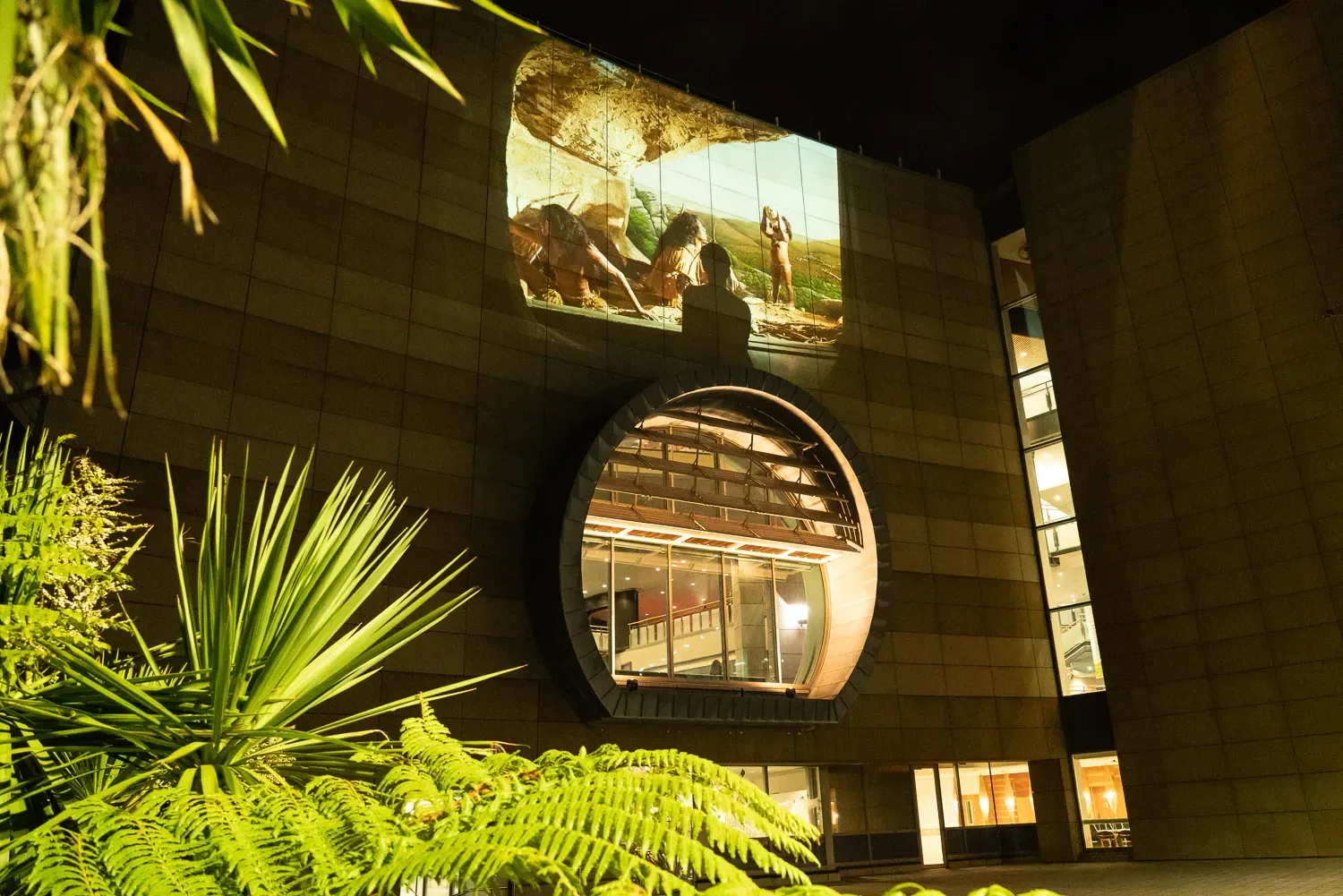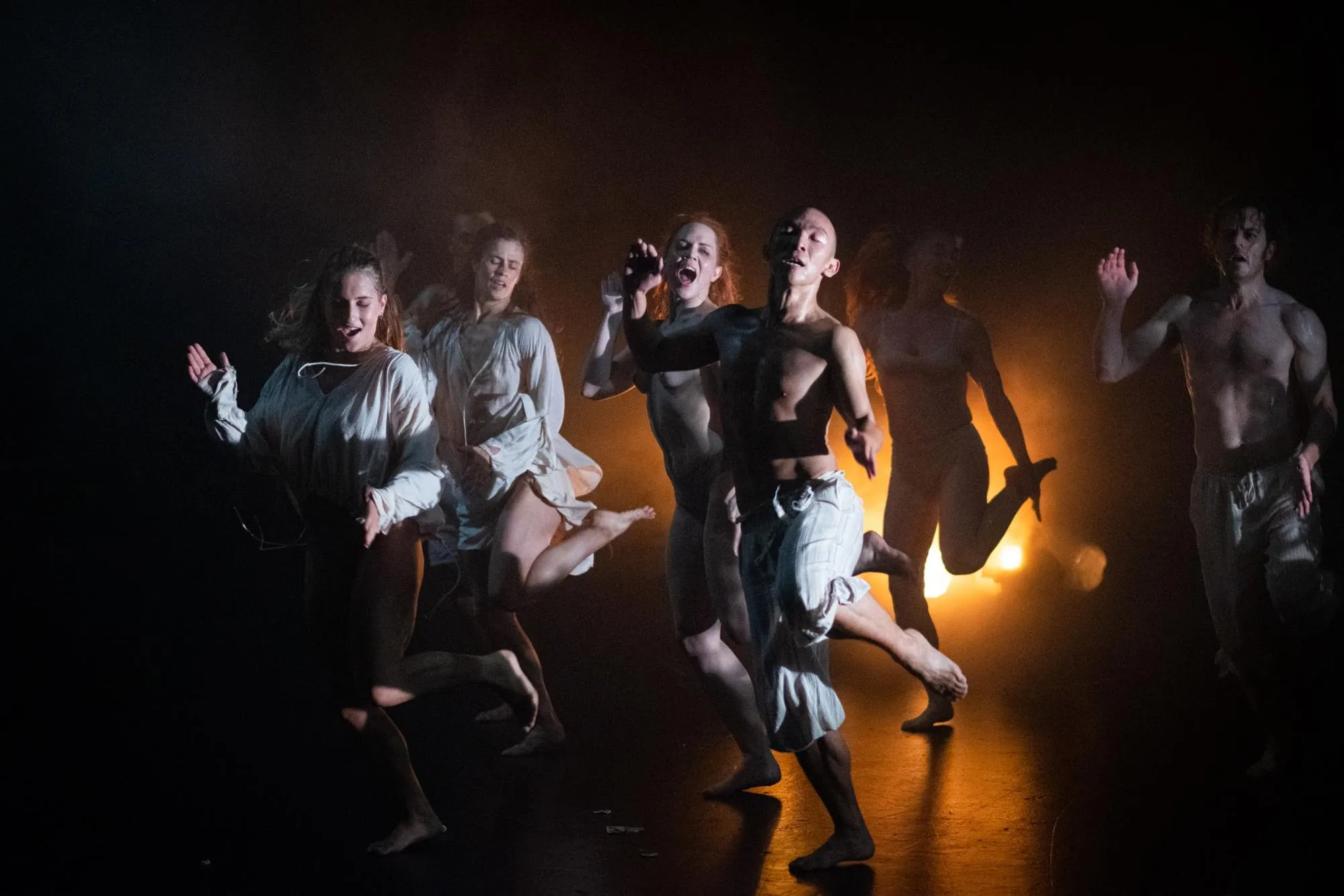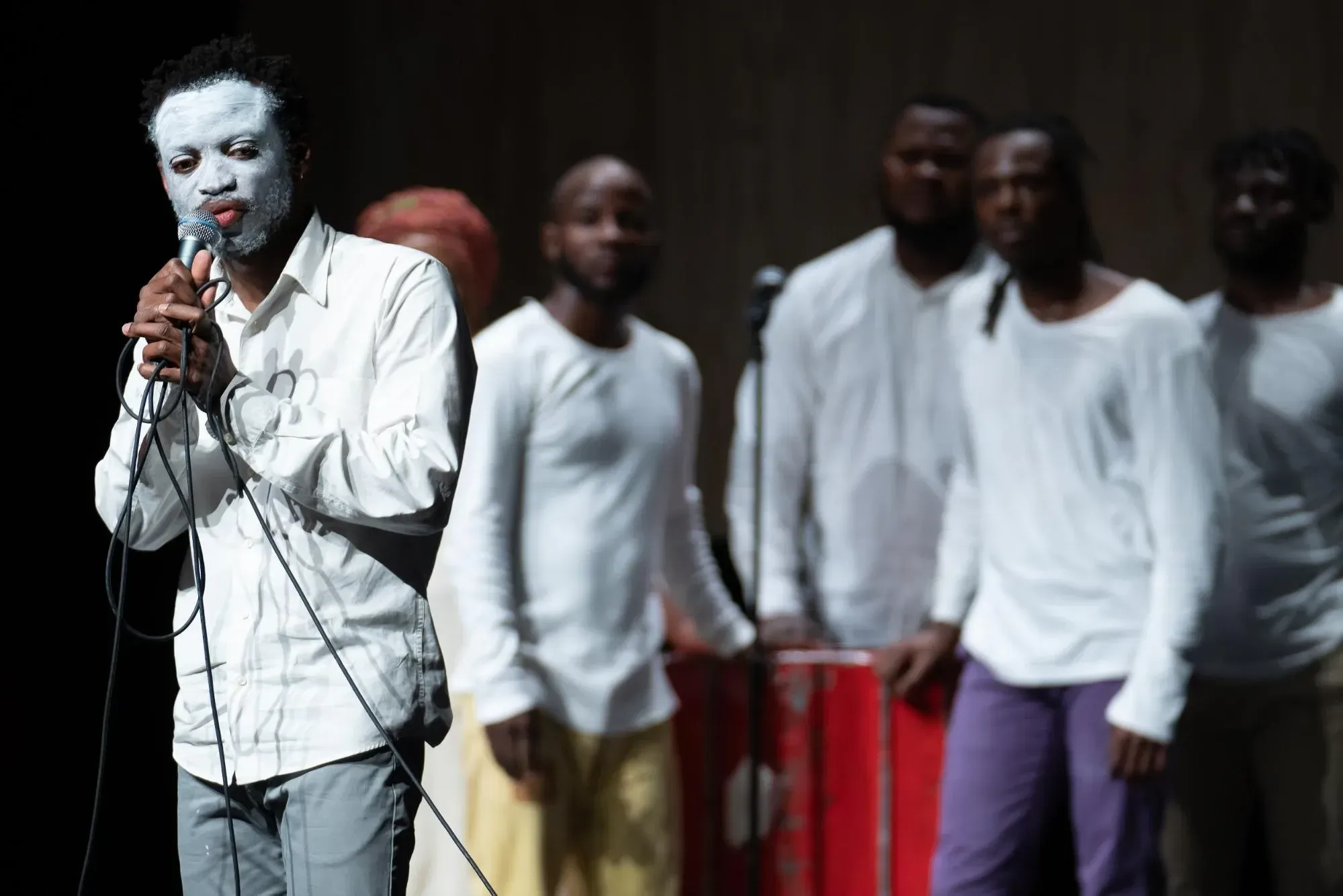Back When We Still Gathered: A Festival in Review
Written by
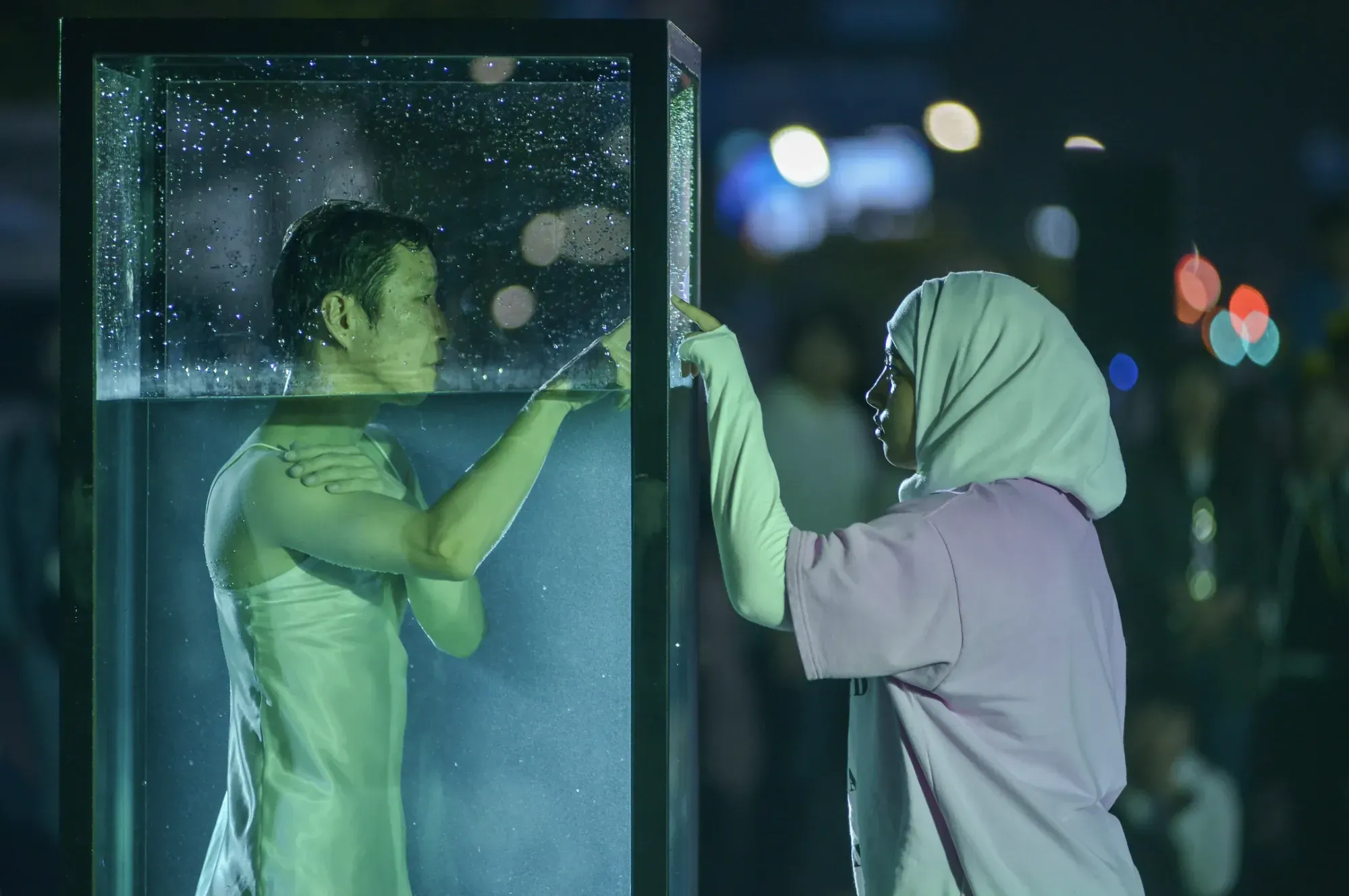
It’s time we talked about performances. Remember those? Here at The Big Idea, artists and the magic they create have been at the heart of what we do for nearly two decades.
And we’ve come back with a deep dive. The type of dive you don’t try without an oxygen tank. But we’ve missed talking about events, so we’re taking you from a famine to a feast.
Mark Amery’s detailed and passionate reflection on New Zealand Festival 2020 takes you back to why the arts mean so much to so many. Grab a coffee, find a comfortable spot (it’s not like you’ve got anywhere to go) and soak it all in.
A few weeks on, it feels like a dream. People congregating, closely packed into theatres to enjoy live performance, massed together on the Wellington waterfront at live arts festival Performance Arcadde - around clothed performers underwater in perspex plinths with Korean company Muljil’s Elephant Laughs. Lying down together in bean bags under a giant disco ball listening to Lou Reed’s Drones, sharing plates in the breaks at the two-day cultural hui, Talanoa Mau.
New Zealand Festival has finished for another two years, losing just its last day to COVID-19. A week earlier, Newtown Festival - which bills itself as the country’s biggest free live music festival - was as usual packed, without a single coronavirus public health announcement. Homegrown and CubaDupa found themselves among the myriad of broken dreams in the dumbfounding weeks that followed.
Never have I gone out so often to then suddenly not go out at all. Which means it’s now time to prepare to go out again: to get ready to make some noise with renewed vigour when this goddamn virus has passed through our public system, whenever that is. My role in that as critic is to help us remember. So here in words and pictures, with the help of sterling festival photographer Matt Grace (except where noted), is my festival A-Z.


A is for Aldous
Currently: Aldous the Adored Aotearoa Artist. “I’m so enjoying myself,” Harding admitted to her gathered fans in one of her awkward out-of-the-blue pearly bursts. “I haven’t enjoyed myself up here for quite a while,” she added, with disarming honesty. Her kooky ‘mime cum puppeteer artist’ veneer (which I respect for its own performance honesty) had fallen. Faced with a technical malfunction that saw her unable to hear her acoustic guitar, she shuffled to the keyboards and performed a new song for the first time since she wrote it. Jaw-dropping.
There was something uplifting about watching Harding work with a sensitive band to keep things going. In its realness of performance, I’m not sure I’ve quite seen anything quite like it.
The lineup - also in Auckland and Christchurch - was a well-chosen triple bill (evoking the 60s, when bands toured like this all the time). Purple Pilgrims won me over live with the way their exquisite vocals weave above the synths in this cathedral of a venue (with a range of gutsy tones well beyond the much-made comparison to one of my favourite bands, the Cocteau Twins). Indie American darling Weyes Blood meanwhile I felt less sure of. I was only occasionally wowed by clever wistful twists on what at times comes dangerously close to ’70s MOR Californian canyon pop.


B is for Bret and The Brief and Frightening Reign of Phil
Without Bret McKenzie, NZ Festival would have been awfully avant-garde.
Bret lightened things in the final week, just when it turned out we really needed it. The heart of his work felt like both its live music programme and this workshop production of this National Theatre musical in development. A terrific combined British and New Zealand company script in hand with clever cardboard props were clearly revelling in getting this on its feet.
George Saunders’ book is a parable for our times, indeed any time. A darkly comic take, straight out of Dr Suess or Michael Leunig land, on the human proclivity to divide off, enforce borders and then turn on each other when disaster hits and someone with behaviour issues is in power. Border guards, detention camps, rents: it could easily have been called The Brief and Frightening Reign of Adolf, Donald, or Boris.
You can see the National Theatre’s smarts in having McKenzie as composer. McKenzie basically throws the American popular songbook at the show, picking up from Flight of the Conchords in a punchy pastiche of different genres. His gift is to take the familiar melodically and lyrically and twist it good. The work is utterly charming, if light. Clearly, some pieces need some work (Freeda’s story - the one character who can stand up to our despot Phil - was in particular left wanting), but this workshop idea was a festival risk that paid off. I can’t help wondering though what it would have been like if the whole thing had been played by Muppets.
C is for The Calling
There is an expression, ‘I think I’ve died and gone to heaven’. With Kopernikus and Laurie Anderson’s The Calling in Lower Hutt, this was both my feeling and the work’s subject.
If Anderson at Michael Fowler Centre was a chamber group in a concert hall, this was a hot jazz venue, with an ‘ensemble completely on improv’ song behind Anderson’s new and recent writing. One theme was the subject of a recent album, what the Buddhists call the Bardo - the state after death before reincarnation. I’d forgotten what a knockout performance poet she is, as well as musician. How, fired up by Andy Kaufman, she is stand-up comedy, jazz and experimental writing melded.
This was as on fire as the Anderson I heard of and watched in the early ’80s but in a jazz improv groove and the work directly fired up by the experience of landing in New Zealand. She spoke of an incident flying here above the Pacific when a man had trouble breathing, and she dreamt that they would all be quarantined on the Auckland tarmac. With the help of Horomona Horo’s sublime taonga pūoro and other Māori instruments, she evoked flying and our birdlife on islands set apart. The risk-taking was inspiring.
The concert ended with her welcoming to the stage Hamid, their taxi driver from earlier in the week to provide a spellbinding chant in the Iranian language of Farsi. “We’re loose here,” said Anderson later to Kim Hill on RNZ, commenting on the improv strength of the composer/musicians in her group. A remarkable inspiring lesson in experience meeting openness.

C is also for Anderson’s Concert for Dogs
This free outdoor concert was principally for just that, dogs. They seemed to be having a ball, including in Skype with Laurie’s mutt in New York. But as a regular human, I couldn’t possibly comment on the quality of the engagement.
D is for Dimanche
This amalgam of remarkable physical and object theatre from Belgium was a Salvador Dali painting come to life. The ordinary becomes surreal due to climate change: furniture melts from the heat, floats due to sea-level rise or, like a Buster Keaton movie, shifts in the face of ferocious winds.
Like Dali, there are magic shifts in scale, the bodies of performers becoming mountain ranges for trees and a car to swish down. It’s all very beautiful and quite disturbing in the violence stage weather inflicts. The technical virtuosity is astonishing, as is the ability of three performers to physically bend themselves into the shapes and spaces of the stage to do it all. And yet the show doesn’t really do much more than reflect the world - it’s not changing my thinking.
The most beautiful moments demonstrate care shown by humans to other living things. This is encapsulated in the relationship between visible puppeteers and their amazing puppets: a giant polar bear and its cub, a cheery elderly lady, a stork and it’s baby on its nest, a shark and attendant reef fish.
E is for Eight Songs for a Mad King
New Zealand Opera’s Thomas de Mallet Burgess has promised to reinvigorate our opera in new spaces, and with this production the reports suggest he achieves it, playing to strong reviews. I didn’t attend this production, but I wandered past it twice. Half the audience with headphones sits in the car park outside the ballet company’s new headquarters, outside looking in at the mad king promenading on top of a table through the windows, complete with orchestra. A quite magnificent sight.
F is for Fired Up
Led by dealers Jhana Millers and Jenny Nelligan, this ceramics festival across 14 galleries was a smart, terrific initiative which reportedly saw a significant upsurge in gallery visits, and demonstrated the remarkable vitality of contemporary ceramics in New Zealand. Private art galleries have been out in the cold from the festival for too long, but here proved why they’re such an asset in their quality and diversity in a compact Capital.


G is for Górecki
The Ponifasio curated opening event of the festival at the Michael Fowler Centre Chosen and Beloved saw the auditorium transformed by Mau company Helen Todd’s lighting installation: Bill Culbert-like dangling fluorescents against a black void magicked up by her sensitive spatial eye. Karanga with ceremony are held by Mau Wāhine, the company’s group of women dancers. Blood is poured on a white sheet pocked by rocks; a mother holds her toddler, the call rings out. Slow bold gestures, handled sensitively to challenge our perceptions of the theatre space.
It was a moving treat to see Górecki’s popular ‘Symphony of Sorrowful Songs’ performed so sensitively by the NZSO, sound sometimes on the edge of perception. The work and production spoke of the wrench of separation between mother and child, people and their homeland. As I have written for the festival: “The music ascended in a grand spiral recognising that, in a time of fear, many feel exiled and excluded. Here, a Polish composer, an Estonian-American conductor and a Syrian singer.” Like many other performers in Lemi Ponifasio’s programme, they convey strength in exile.
H is for Here Comes the Ocean
Again in the grand Michael Fowler Centre - that Laurie Anderson described aptly as an upturned wooden boat - she and her ensemble with guests gave a concert which, in comparison to The Calling, felt disjointed and powerful in exploring ideas and stories. For those seeing her for the first time at this festival - back in the venue she was in at the very first NZ Festival in 1986 - I can appreciate that her energy here was a balm. But for those I spoke to who saw both concerts this was, by comparison, a concert of loosely-hung together moments rather than the rise and fall of an improvised poem where everyone is with each other.
It started with a crescendo - Lou Reed’s Drones, Horomona Horo’s taonga pūoro, Balinese gamelan... it felt like the kitchen sink thrown in. There were many special moments I’m glad I didn’t miss: getting everyone to scream in response to the state of the world (incredibly, Christchurch not COVID9 was on the mind), the appearance of young members of Porirua’s Virtuoso Strings (an idea she had the night before), a spontaneous set of tai chi and some great Lou Reed songs - yet the cake never rose, with Anderson not diving into our relationship with the ocean to any depth. In this case, the spine felt too loose.


I is for Ilbijerri
...and Te Rēhia Theatre Companies.
Black Ties is the first co-production I can recall between Māori and Aboriginal companies. Co-written, co-designed and co-performed - a marriage, creating a work about marriage, Black Ties is also a symbol of Auckland Māori theatre coming of age - a production coming from Auckland to Wellington, rather than visa versa. Utterly charming, the work revels comically in the misunderstandings of tikanga between two cultures, as the eccentric friends and families of two lovers meet. It has all the moves of a lighthearted, down under romcom movie blockbuster, except here we get to participate.
There’s nothing much funnier than some young Aboriginal dudes at a shambolic pōwhiri at a marae in Ruatoki in Tūhoe, where the taiaha is a broomstick, and a jandal gets used as pūtea. The performances are relaxed, cheeky, informed by the showbiz ease of Māori showbands past, and crucial is a Trans-Tasman band, led by Laughton Kora who play throughout, shadowing the characters for laughs and funky grooves. For the second half, the fourth wall is torn down, and we are part of a wedding reception in real-time with its requisite meltdowns and final comings together on the dancefloor. Timewise that could do with really being punched up, and there’s really very little plot, but it’s just a joy from start to end.


Image: Jeff McEwan
J is for القدس Jerusalem
This new work by Lemi Ponifasio and Mau company was a startling, if raw, urgent call for peace and understanding. Jerusalem is a central charged symbol for the way our gathering spaces contain the histories of many cultures and beliefs; many of them denied a voice. In response it was the call of the oppressed returning - largely in te reo Māori - moving isolated in and out of a cube structure, testing out the relations of space on stage in new ways.
Quite breathtakingly, action occurred far into the distance, against the theatre’s brick back wall. There were many riveting moments, but ironically, given the theme, everything felt fragmented, disparate. The words of the Syrian poet Adonis that helped inspire the work almost tellingly were hard to read on the back wall. Ponifasio makes no apologies for not offering translations, but even so, things were hard to comprehend. In its coming together of many fascinating magnetic parts, from the sounds of a Kiribati choir to the magnificent solos with spanner and rifle of Rosie Te Rauawhea Belvie and Kāwiti Waetford (in remarkable voice in karakia), it felt uncertain rather than bold, but its motion nonetheless touched me.

K is for Kate Tempest
After the first week of the festival, I felt an enormous sense of hope for the future, principally from the performances of the young. Kate Tempest capped that off. Surging over the synths, she rides a wave with her voice, delivering her entire new album as one big song cycle. The bass meets the lighting strobes, and after acknowledging the room, she pours out stories of empathy from human encounter; the reclaiming of dignity afterlife has reached its lowest ebbs. The message fits snugly with everything else I’ve heard over the festival first week: in ‘People’s Faces’: “There are no new beginnings until everybody sees that the old ways need to end” and an abiding message that love is in both the giving and receiving.
L is for Lemi and Laurie
One of the most refreshing things about this festival’s shape was the curation given to artists. Lemi Ponifasio and Laurie Anderson particularly shaped their weeks strongly and gave it their maverick energy.
I heard people call Ponifasio’s programme bleak. I thought rather the work confronted and then recognised the humanity that comes out of crises. Conference Talanoa Mau and Ponifasio’s programme in Porirua were at the heart of his curation, to break the familiar expectations we have of a festival programme and suggest some new ways forward. That meant facing our mental health issues, our fears and then grasping the inspiration to move forward. This festival gave me this tangibly with Laurie Anderson’s work; providing examples of how to behave and be free: peacefully, collaboratively, ever inventively.
L is not for Lou Reed’s Drones
If you want to hear really dynamic sound artwork, check out Pyramid Club in Wellington, Audio Foundation in Auckland, or a myriad of small venues in Dunedin and Christchurch. Here a blissful chorus of feedback from Lou’s guitars provided meditative mantra but lit with a giant disco ball, it was all, I thought, rather empty.


M is for MÁM
Irish dance company Teac Dansa here with my favourite kind of performing art: electric dance sending sense into a whirling, twirling, body-celebrating frenzy. Michael Keegan-Dolan’s work is a homage to his Irish ancestry in the form of the ceili.
Many people see formal set dancing, or Riverdance, when they hear ceili. I see what I revelled in the middle of the night on the wild western fringes of Ireland in country halls: something ecstatic and mad that calls up every demon and God to the floor to then expel them.
Led by a phenomenal concertina player Cormac Begley, he and the floor are closely miked, so that every wheeze and foot tap is fundamental to the percussive onward hurtle of the piece. Later they are joined by an extraordinary musical ensemble, Stargaze from Berlin. A dozen dancers hurtle across space, examining relationships between people with passion in every possible way. It makes you ache to dance, to celebrate these bodies we live in, in communion with each other.


N is for Nightsong
This excellent theatre company from Auckland continue to produce unique, smart, funny theatre that makes you think about the power of stories. They again delivered the goods with the utterly charming Mr Red Light at Circa, a meditation on supporting each other to not give up on yourself when you feel utterly stupid. Don’t miss their show, Te Po, when it next tours
O is for Obioma
Here as part of the festivals writers’ programme, Chigozie Obioma spoke powerfully at two-day conference Talanoa Mau. As I write in an essay to be published by NZ Festival: “Demonstrating the power of the story, Obioma told of his youthful fascination with the safety message on the side mirrors of his Dad’s Peugeot, “Objects in mirror are closer than they appear”. Is it then a bad mirror? No, it is how it is designed. Obioma equated this to another saying, from his own traditions: we hear a drum clearer from a distance.”
Distance provides us clarity and reflection: “Artists must develop new lenses to reevaluate the world,” Obioma said. “Perception should come not just from what you have seen but what you have observed... how many wars would have been prevented?” Here, then, is some vital work for the writer and the artist.

P is for Peter Sellars’ Kopernikus
Wunderkind director Sellars loves to ruffle feathers with the radical. He was once run out of Adelaide Festival for his provocations. Indeed, opera Kopernikus turned out to be one of this festival’s most controversial works. I struggled with its static pretension for the first half-hour, dozed and then, renewed, realised I was somewhere foreign but celestial. An astonishing dreamlike work by French-Canadian composer Claude Vivier, who died tragically young, rendered by American vocal group Roomful of Teeth and the French Ensemble L’Instant Donné.
I felt like I was in some Midsummer Night’s Dream lovers’ feathery bower in some otherworldly woods. Exquisite, this was some intergalactic space inspired by Balinese cremation rituals, melodic Mozart and the nonsense of Lewis Carroll. If the international festival is about being both challenged and mesmerised, with its strange perfume lingering for days, this was ground zero.
Q is for Q&As
I’d like to raise the issue of the commodification of conversation, which strode into the limelight recently with the Margaret Atwood tour. While the festival offered a fantastic well-attended set of free discussions with artists after or before their shows (vital public space), we continue to be expected to pay lots of money to attend writers’ talks, and even one with Laurie Anderson. If these were funded so they could be free to participate in like they are at Adelaide Festival’s Writers Week, might we buy more books instead?


R is for Roaming Hut
The closest this festival got to a free central public gathering venue was a cross between a Sprite pop-up caravan and scout tent. Not exactly a Spiegeltent. Ingeniously designed by artists Kemi and Niko from recycled material, this wee trailer popped up outside many a festival venue (here I snapped it outside Laurie Anderson’s The Calling at the Lower Hutt Events Centre), hosting an alternative programme of talks and activities.
It could have just been a promo vehicle for Urban Hut Club but instead, from a balloon installation to dive into from Shared Lines Aotearoa, to a dog drawing session with cartoonist Sharon Murdoch at Concert For Dogs, it was the liveliest art space in town.
S is for Släpstick
My disappointment of the festival. I enjoyed the audience participation, the pillow fights, and the musicianship. Still, I kept waiting for this slick, charming Dutch clown show to deliver some real surprises (beyond those borrowed from Chaplin and Keaton) or some human pathos. I can appreciate how it might charm the trousers off you in a small fringe venue, but in the opera house, it felt a little overblown and empty of new ideas. Nuff said.

T is for To the Moon
Laurie Anderson’s VR installation at the Dowse Art Museum continues till June and is a must-see (lockdown permitting). You need to book online. I had a strange experience. Taking off my goggles after 20 minutes on the moon in a jetpack roaming around all manner of galactic wonders, with Anderson as my guide in my ear, I came face to face with her at the Dowse. It was like one of Anderson’s own stories of technology meeting human interaction, space and time collapsing.
I would have liked more of Anderson’s visual art at the festival, but here at least you get to experience her giant painting work on an even larger canvas, skipping across the moon’s surface with the constellations dancing into fantastical free and surreal forms, as if it were some elephantine 3D blackboard in the sky. Developed last year with multimedia artist Hsin-Chien Huang, it’s an impressive example of what virtual reality can now do from someone with a desire to give us the experience of flying.

U is for Urban Hut Club
Kemi and Niko’s miniature huts can still be visited up and down the Kāpiti Coast. Pictured is the smallest in Waikanae. Visiting these with my family was one of the highlights of the summer, discovering what beautiful wildness is on my own doorstep. Take the Paraparaumu hut at Kaitawa Reserve. Wharemauku stream is best known as a straight channel through Coastlands shopping centre, populated by ducks and McDonald’s litter. A kilometre upstream, however, it turns out to be a serpentine wonder, swirling through a miniature canyon. With directions in hand, there’s a small bivvy to rest in off the track here, by the stream, with a visitor’s books ingeniously concealed for you to add your own creative thoughts.
What I appreciated about many of these huts is how they have sympathetically been positioned and created to speak to the environmental restoration work of the community groups the artists have worked with. You can find a map and stories commissioned for each hut online.

V is for the visual arts
This festival was noticeable for its absence of major international visual arts shows or public installations. This is not good. Beyond Laurie Anderson this year, the partnership between the festival and our public galleries seemed absent. The festival is an opportunity to welcome wider audiences to some dynamic international cross-media work: Bill Viola, Simon Starling, Janet Cardiff and Joseph Kosuth in the past to name a few.
Absent were major free temporary public installations in the Wellington CBD drawing the many. Instead Into the Open was a nighttime series of projected moving image works along the waterfront, changing each week with the curators. This was a noble idea but lacked a robust supporting programme and ways for participation. A major interactive public art commission would have better ignited the public imagination. Which brings us to...
W is for Wellington Waterfront
I first reviewed the festival in 1990 as a young 95bFM arts presenter and producer from Auckland. I slept on the publicist’s floor in Oriental Bay, dined with the Wynton Marsalis band, and stepped on a French ballerina’s toe at the Boatshed festival bar. The fringe was barely out of its BATS creche and down Alpha Street at the Cambridge Pub and Taki Rua Depot theatre.
Back then, more of the waterfront was contested commercial territory - the festival was part of its co-option by the public. Today bars overflow into public spaces; beanbags, tables and chairs are everywhere; The Taranaki iwi of Te Atiawa take tourists out on waka from their magnificent Wharewaka. Events during festival time are plentiful.
And yet what I missed most about this festival was a sense of public gathering beyond the ticketed areas. I wanted to know where to hang out for a drink in the night air to mingle with others after the show and bump into more French dancers. This sharing (which with COVID-19 we’re now missing) is a big part of what makes a festival tick. Bring back the Boatshed.

X is for Xin Ji
I didn’t get to see this superb dancer in Strasbourg 1518. It was cancelled after two of its four shows, which saw me and many others miss out, on the back of great reviews. We have to make do with the beautiful production images of Vanessa Ruston. It was filmed by Jeremy Brick. I hope it might be released online. We await its restaging, which should come with healthy funding from the government to enable the artists to gather and a venue to be secured.

Y is for Yves Mwamba
Yves was one of the superb performers in Faustin Linyekula’s performance work In Search for Dinozord, a response to dealing with the horrors inflicted on their homeland of the Democratic Republic of Congo. Not easy watching, there’s a genuine sense of searching for new forms to deal with new society and its traumas drawn from the past.
The dancing is twitching and animalistic, bending contemporary theatre into fragments of opera and half-remembered traditional forms. No answers are offered; instead there’s the sense of artists searching lumbered with a past. The work sits uncomfortably in Te Papa’s Sounding Theatre. It felt made for a shared floor, able to be mounted anywhere at any time.
Z is for Zoo Eyes
A beautiful song by Aldous Harding performed by a cracker band in a gentle swing. The line “What Am I Doing in Dubai?’ has been echoing in my head ever since as I think of stranded New Zealanders trying to get home. Aldous is artist; at the beginning and the end.
